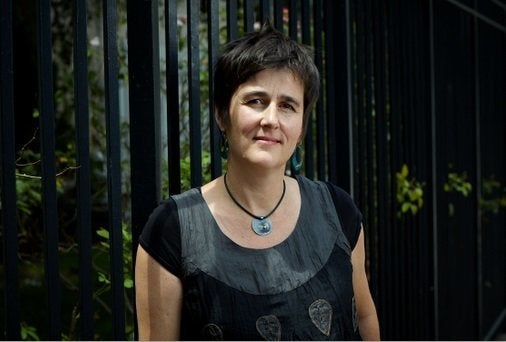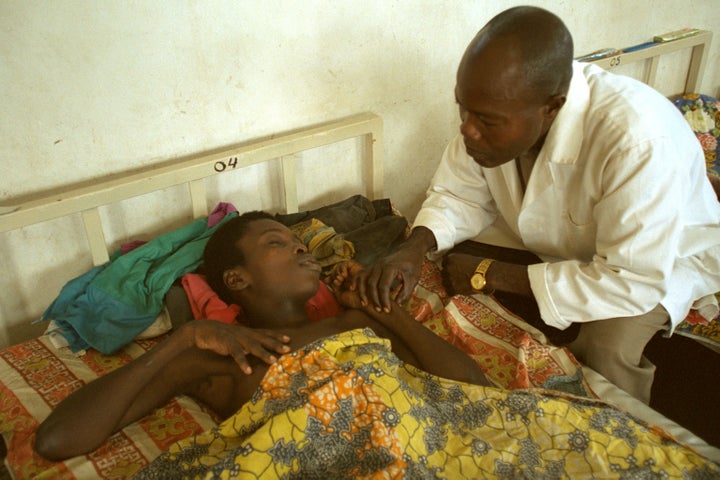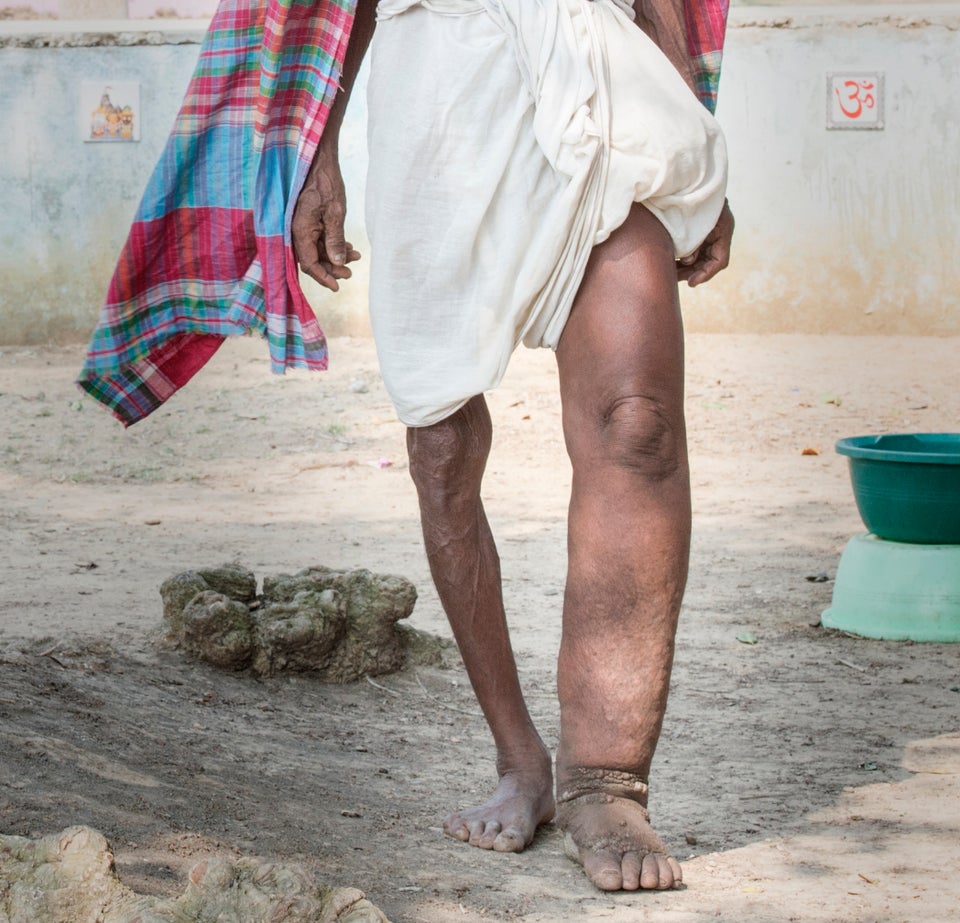This article is part of HuffPost’s Project Zero campaign, a yearlong series on neglected tropical diseases and efforts to fight them.
One morning a few years ago, a vial containing just a few drops of a long-forgotten drug candidate arrived at the office of bioengineer Els Torreele in Switzerland.
The compound, fexinidazole, had been studied at a drug company several decades earlier, but researchers had given up on it for no clear reason. Torreele had asked the company to unearth whatever it had left from its archive, hoping to get her hands on the final clue in a long process of painstaking detective work.
This was one of hundreds of drug samples Torreele had been chasing. She and her team were reaching out to scientists around the world, seeking a potential medicine for a neglected tropical disease that was in dire need of a new treatment: human African trypanosomiasis, also known as sleeping sickness.
Torreele hoped the compound she was looking for was hiding somewhere in a dusty drawer full of old research, waiting for someone to locate it and put it to use. And after years of searching and testing, it turns out she was on to something. What she and her team found could transform the way a deadly disease is treated.

Sleeping sickness is caused when the blood-sucking tsetse fly bites humans, transmitting the microscopic parasite Trypanosoma brucei. The parasite stays in the blood for months or even years, causing bouts of flu-like symptoms.
Eventually, the parasite passes the blood-brain barrier and invades the nervous system. In this second stage of the disease, patients experience neurological symptoms, their sleeping routine gets completely disturbed and, without treatment, they eventually slip into a coma and die.
The disease is endemic in 36 sub-Saharan African countries, putting about 13 million people at risk of infection ― particularly in the Democratic Republic of Congo, where the majority of cases occur. While sleeping sickness has taken hundreds of thousands of lives during outbreaks, public health efforts have kept it at bay and current cases have fallen to about 3,000 a year.
That means there’s a chance to interrupt the disease’s transmission ― but finding safe and effective treatments is essential. For decades, the main drug was an arsenic compound dissolved in antifreeze, which killed 1 in 20 patients within a few minutes of injection. The current treatment is safer, but requires IV infusions and lengthy stays at hospitals, which are not very common in rural and remote places where the disease is most prevalent.
Fexinidazole is not quite ready for prime time, but if the final steps are completed successfully, it will come in pill form, making it easy to administer in places with minimal health care infrastructure. Moreover, it will work for both the early stage of sleeping sickness and the late stage, when the parasite has invaded the brain. This means that doctors wouldn’t need to perform the painful medical procedure known as lumbar puncture ― inserting a long needle in the spine ― to diagnose the second stage. They could just give the medicine to anyone who has the parasite in their blood.
“That would be a real breakthrough. You would be able to diagnose people just by blood test and treat them with a 10-day course of tablets. That’s going to be really transformative,” Torreele said.
But this breakthrough wouldn’t even be possible without an effort to improve communication between researchers in university labs and health care providers working in Africa to treat sleeping sickness. A 1999 paper from Doctors Without Borders (also known as Médecins Sans Frontières, or MSF) made the divide clear, describing challenges like counterfeit drugs, the high costs of existing treatments ― and research and development programs that were not motivated to look into drugs for neglected tropical diseases.
The latter point struck Torreele as odd. At the time, she had been working with researchers in the very field the paper claimed needed more attention, investigating the parasite that causes sleeping sickness at the immunology lab at the Free University Brussels. The parasite was incredibly interesting to immunologists who wanted to decipher how it could avoid being detected by the immune system.
So Torreele got in touch with Bernard Pécoul, one of the authors of the MSF paper, and told him about the communication disconnect between researchers and health care providers.
“We don’t talk to each other because we are at the two ends of the normal spectrum of the R&D process,” Torreele told The Huffington Post. “An interesting finding occurs in basic research in universities, and there’s an expectation that it would be picked up by the pharmaceutical industry who will then transform it to a product that is available for doctors. But for many neglected tropical diseases, including sleeping sickness, we realized there’s no such intermediary.”

To help bridge this divide, Torreele joined the MSF Access to Essential Medicines Campaign and worked with the Drugs for Neglected Diseases initiative (DNDi), a nonprofit drug discovery think tank that Pécoul leads and which was kickstarted with MSF’s Nobel Prize money in 1999. (HuffPost is raising funds to support DNDi’s efforts to eliminate sleeping sickness.)
Torreele’s team was responsible for finding research that could help develop medicines for sleeping sickness. By diving into scientific literature spanning decades, Torreele and her colleagues zeroed in on promising compounds that had never been taken forward into development. These compounds had been tested in vitro and sometimes even in animal models — some could cure mice of the sleeping sickness parasite.
The team then started to reach out to the scientists who had published those results. “What is published is only a minor fraction of what people actually do, so you can get a lot of information by actually talking to some of these scientists,” Torreele said. “They were actually very flattered that someone 10, 15 years later got interested in the research they had done.”
With the help of those scientists, Torreele’s team identified over 700 compounds that could be useful in battling sleeping sickness more effectively than current treatments.
“Then we tried to get samples, so we wrote to the people in the labs and pharmaceutical companies, and they went back to their libraries trying to see if they could find a few milligrams of their compounds still left,” Torreele said.
Eventually, the team landed on fexinidazole, which was first developed by drug company Hoechst (now part of the global pharmaceutical firm Sanofi) in the ‘80s. Once the team proved the drug was safe, it entered clinical development and is now nearing the end of its last stage of trials in human subjects. DNDi and its partners are hoping it will be available to patients by next year.
“What is published is only a minor fraction of what people actually do, so you can get a lot of information by actually talking to some of these scientists.”
- Bioengineer Els Torreele
The approach Torreele’s team used to find fexinidazole could work for other diseases as well, she said. Torreele, who now works at the Open Society Foundations to advance health and human rights, noted that it could dramatically reduce exorbitant R&D costs for drug development.
Fexinidazole “is an excellent example of drug discovery scientists ‘rescuing’ a compound that was otherwise in the dustbin of a large drug company,” said Michael Pollastri, an associate processor in medicinal chemistry at Northeastern University who wasn’t involved with this research, in an earlier interview with HuffPost. “It’s a perfect example of how valuable it can be to revisit ‘failed’ drugs and to carefully consider whether new evidence can be produced to revive the compound.”
DNDi still has work to do to bring fexinidazole to patients. After completing its clinical trials, the drug has to be tested on children, pregnant women and other vulnerable populations. It also has to be tested on a less common variant of sleeping sickness, which comprises only 2 percent of cases but is currently treated with the highly toxic arsenic-based drug.
Moreover, DNDi is also working on a more powerful drug with a shorter regimen that is easier to administer. Some experts believe that these two drugs could help eliminate sleeping sickness in the next few years. The World Health Organization says this will be an immense task, but the new treatments could be instrumental in this process.
“It is expected that these medicines, once developed and approved, can greatly help in eliminating the disease,” Ashok Moloo, a spokesperson for the WHO, told HuffPost.
DNDi is a recipient of grants from the Bill & Melinda Gates Foundation, which also funds HuffPost’s Project Zero series. All content in this series is editorially independent, with no influence or input from the foundation.
If you’d like to contribute a post to the series, send an email to ProjectZero@huffingtonpost.com. And follow the conversation on social media by using the hashtag #ProjectZero.
More stories like this:


